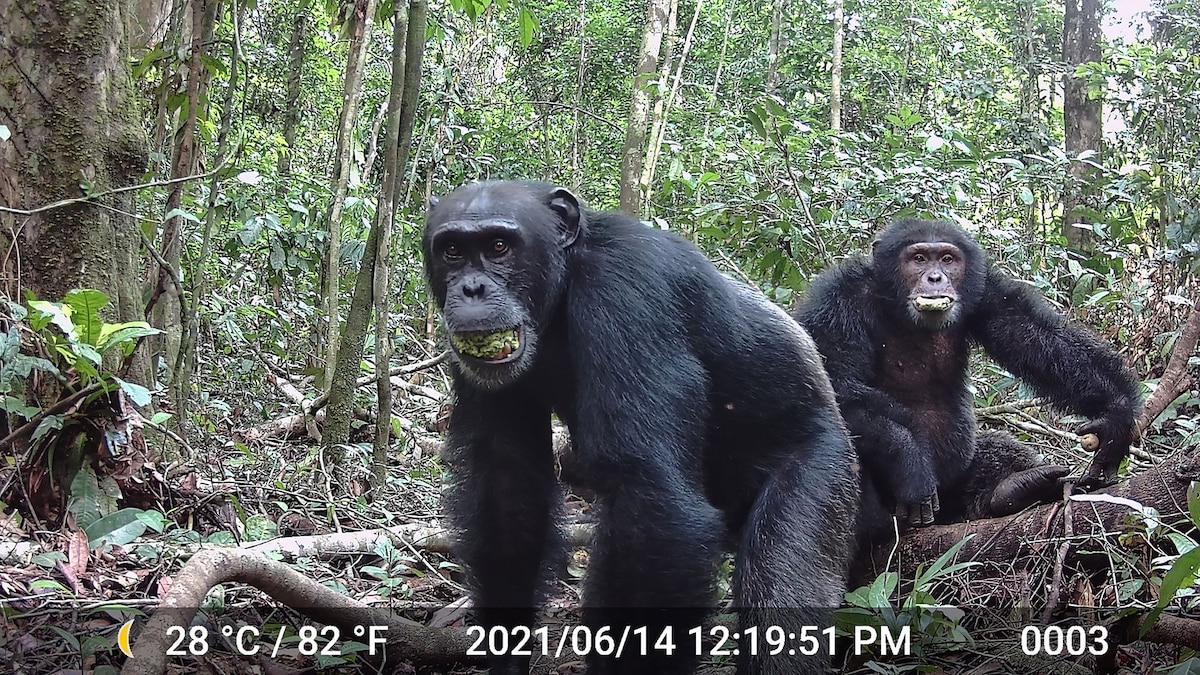
Our closest living primate relatives may prefer tree-hopping over bar-hopping, but they do consume quite a bit of alcohol through their food, a new study finds.
Primatologists had long suspected that chimpanzees ingest sizeable amounts of alcohol, given their preference for ripe fruits, which can ferment naturally as yeast from the environment convert their sugars into alcohol. But a study published in Science Advances this week is the first to estimate their daily alcohol consumption, based on an analysis of more than 500 fruits found below trees where chimpanzees recently fed, their daily food intake, and the amount of time spent eating different fruit species.
This allowed scientists to calculate that, taking into account their lower body weight, chimpanzees consume the equivalent of 2.5 human drinks per day on average.
“The dataset is convincing, representing a wide array of fruits ingested at sites in East and West Africa,” says evolutionary biologist Nathaniel Dominy of Dartmouth University, who was not involved in the study. “These findings are bound to stir debate and move the discipline forward.”
The study’s scientists suspect the chimps are seeking out these alcoholic fruits on purpose. In two different chimp populations, biologist Aleksey Maro of the University of California, Berkeley, and colleagues discovered that the most popular fruits for each group had some of the highest alcohol levels: a kind of fig at Ngogo in Uganda’s Kibale National Park and a kind of plum in Côte d’Ivoire’s Taï National Park.
Alcohol content may signal to the chimpanzees that a fruit has a high sugar level, Maro says, and that the fruit has more available nutrients because it has reached a certain level of fermentation. “But the alcohol might also be appealing in itself,” Maro adds.
50% OFF
Starting at $17/yr
Given that chimpanzees and humans share a lot of genetics and evolutionary history, the study supports the idea that our attraction to alcohol may date far back in time.
Not necessarily drunk
The fig at Kibale and the plum at Taï aren’t super boozy; they only contain about 0.3 percent alcohol. But since a chimpanzee can ingest around 10 pounds of fruit a day, that amounts to an average daily dose of 14 to 15 grams of alcohol. A standard human drink is about 10 grams — but since chimps weigh much less than humans do, 14 to 15 grams to them is the equivalent of around 2.5 human drinks per day.
“They’re doing that over the course of breakfast, lunch, and dinner,” says Maro, so to speak, because chimps eat more or less throughout the day. But when they find a tree heavy with their favorite fruits, they sometimes engage in “binge eating,” stuffing their mouths with as many figs as they can fit, sucking out all the juice (and alcohol), then spitting the dry wad onto the forest floor. But unlike unhealthy binging behaviors in humans, this is considered normal and natural — scientists say, it’s just what chimpanzees do.
The study is not without shortcomings. Biologist Matthew Carrigan of the College of Central Florida, points out study authors did not directly consider how many fruits the chimpanzees really ate, just how much time they spent eating different types. Primatologist Karline Janmaat of the University of Amsterdam, the Netherlands, also points out it remains uncertain whether the fruits dropped or left behind by the chimpanzees may be higher or lower in alcohol than the ones they ate.
Maro acknowledges that it would be good to measure more directly how much alcohol chimpanzees have actually consumed, something that might be done with urine samples he has recently collected. That could cast more light on the possible role of alcohol in the aftermath of some large gatherings of chimpanzees observed in trees with abundant ripe figs in Kibale National Park.
A lack of restraint
Even if the study’s estimates are accurate, Janmaat cautions that chimpanzees probably don’t, and shouldn’t, get drunk in the wild. “That’s very dangerous when you need to climb high up in a tree to build a nest to sleep at night.”
Still, if given unlimited access to alcohol, chimpanzees may not know when to quit. In the 1960s, an experiment that would not be permitted today showed that when chimpanzees could drink as much alcohol as they wanted, some didn’t touch it, while others drank until visibly drunk.
Wild chimpanzees in Guinea have been observed using leaves as sponges to access fermented palm sap from the containers people use to harvest it, says conservation scientist Kimberley Hockings of the University of Exeter, who helped conduct that research but was not involved in Maro’s study. “Multiple chimpanzees ingested this alcoholic beverage, often in large quantities, despite an average presence of 3.1 percent and up to 6.9 percent alcohol by volume.” Some of them were behaving a bit odd afterwards, but she adds that this is an unusual situation and that “chimpanzees are unlikely to get drunk on fruit.”
There may be a genetic explanation for why. An earlier study by Carrigan and colleagues revealed that chimpanzees, humans and gorillas share a genetic mutation in an enzyme involved in alcohol metabolism that works 40 times faster than that of other primates. This means that if they’re consuming alcohol in their food rather than in one human-like gulp, much of it might be broken down before it reaches the blood.
Ganging up
As in humans, alcohol may also play a role in social bonding for chimps. Hockings was recently involved in a study that found chimpanzees in Guinea-Bissau shared naturally fermented fruits with each other, and suggests “the sharing, and dietary incorporation, of ethanol-containing foods is extensive and may have played a long-standing role in hominoid societies.”
The plentiful presence of food reduces social tensions, which may allow bonds to be tested and strengthened. After stuffing themselves with figs, Maro explains, groups of male chimpanzees sometimes disappear into the forest together to hunt for monkeys or patrol the boundaries of their territory.
“Patrolling is a dangerous activity, since chimps of different groups risk death in an encounter. It’s tantalizing to think that the alcohol in the fruits might help them to gather up their courage first,” Maro said.



